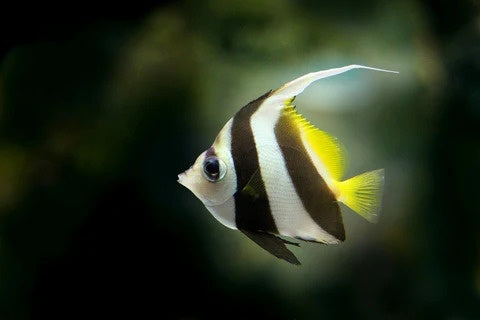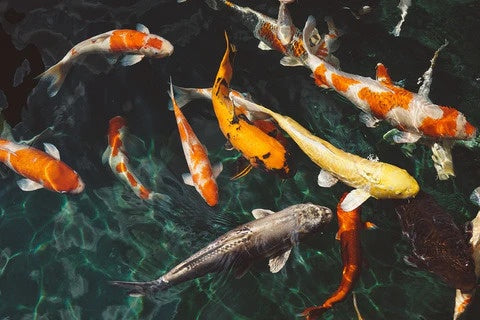While aquaponics primarily focus on cultivating edible plants and fish, integrating ornamental fish species can add aesthetic and functional dimension to your system. Raising the right ornamental fish not only enhances the visual appeal of your aquaponics setup but also plays a crucial role in nutrient cycling and ecosystem balance.
This blog discuss the use of ornamental fish in aquaponics systems. We will explore the best ornamental fish that add a splash of color and personality to your system, all while providing essential nutrients for your plants.Whether you're a seasoned aquaponics enthusiast or a beginner looking to elevate your system, understanding the best ornamental fish for aquaponics is essential for creating thriving and beautiful aquaponics system.
The advantages of raising ornamental fish in aquaponics :
- Enhances the visual appeal of the aquaponics system
- Provides additional income potential through the sale of ornamental fish
- Contributes to nutrient cycling and ecosystem balance
- Offers an opportunity for hobbyists to enjoy and observe beautiful fish species
- Increases diversity within the aquaponic ecosystem
- Can serve as a natural pest control mechanism by consuming insects and larvae
- Supports education and learning opportunities, especially for children and students
- Promotes relaxation and stress reduction through the calming presence of fish
Factors to Consider in Selecting Ornamental Fish
1. Compatibility with aquaponic plants:
Ornamental fish must be compatible with the types of plants being grown in your aquaponics system. Some fish species may nibble on plant roots or disturb the root system, which can hinder plant growth. So it's essential to choose fish that coexist peacefully with the selected plants to ensure both thrive in the system.
2. Temperature and pH requirements:
Different ornamental fish species have specific temperature and pH requirements for optimal health and growth. It's crucial to select fish species that can tolerate the temperature range and pH levels maintained in the aquaponics system. Failure to meet these requirements can lead to stress, illness, and even death among the fish.
3. Growth rate and size:
Consider the growth rate and adult size of ornamental fish species when selecting them for your system. Fish that grow too large for the tank or reproduce rapidly can overcrowd the system, leading to water quality issues and potential harm to other fish and plants. Choosing fish species with moderate growth rates and manageable adult sizes helps maintain a balanced ecosystem.
4. Nutrient production and waste tolerance:
Ornamental fish contribute to nutrient production in aquaponics systems through their waste products, primarily ammonia and nitrogen compounds. It's essential to select fish species that produce sufficient waste to provide nutrients for plant growth without overwhelming the system with excess nutrients.
5. Feeding habits:
Understanding the feeding habits of ornamental fish is critical for maintaining a healthy aquaponics system. Some fish species are herbivores, while others are carnivores or omnivores. Ensure that the chosen fish species' dietary requirements align with the available food sources in your system, such as algae, aquatic insects, or supplementary fish feed. Proper feeding practices help prevent overfeeding, nutrient imbalances, and water pollution in the aquaponics system.
The Best Ornamental Fish for Aquaponics Systems
Below is the list of ornamental fish you can raise in your aquaponics system.
1. Goldfish
Ideal pH range: between 7.2 to 7.6
Ideal Temperature Range:between 65°F and 72° F
Ideal Fish Tank Size: Goldfish need space to swim around, so it is essential to use a longer and bigger tank if you’re planning to keep more than one fish.
Food Requirements: Goldfish are omnivorous, but it is recommended to feed them with pelleted fish feeds that are high in protein.
Goldfish is one of the most popular ornamental fish in aquaponics. Not only are they inexpensive and look great in your home, but they are also a hardy fish species that is easy to take care of. Goldfish can survive in a wide range of temperatures, water conditions, and changes in water pH levels. They also produce large amounts of waste, which provides plenty of nutrients to your aquaponics plants. Here are the reasons why goldfish are ideal for aquaponics:
- Easy to breed: Goldfish are hardy and easy to breed, which is an advantage in aquaponics systems.
- Readily available: Goldfish of different sizes are readily available all year round worldwide.
- Affordable: Compared to other aquaponics fish species, most goldfish are inexpensive. Their food is all cheaper and available globally.
- Water quality tolerant: Goldfish are resistant to poor water quality conditions.
- Great indoors: Goldfish are great for smaller indoor aquaponics systems. Their beautiful colors can complement any indoor decorations and setting.

2. Angelfish
Ideal pH range: between 6.8 and 7.8
Ideal Temperature Range:between 78-86°F.
Ideal Fish Tank Size: Angelfish can grow quite large and requires an aquarium of at least 55 gallons or larger.
Food Requirements:Angelfish feeds at the surface or mid-water, but they also swim to the bottom to look for worms and other small crustaceans. They are omnivores and thrive on flakes. They can also be fed with frozen and live foods to help induce spawning.
Angelfish is another popular ornamental aquaponics fish because of its long and majestic fins, graceful swimming behavior, and ease of breeding. Angelfish belong to the family of Cichlidae. They look good in aquariums and are admired for their classy swimming behavior.
When buying angelfish, look for ones that are the size of half a dollar coin (2-3cm). Part of the fun of keeping angelfish in your aquaponics system is watching them grow from a young fish to full adulthood. While they are slender fish, don't pick overly thin ones. Look for a young, strong angelfish with a thicker head and meaty body. Also, avoid buying any fish with cloudy or damaged eyes. Buy only the healthiest ones possible for the best chance of a successful system.

3. Bloodfin Tetras
Ideal pH range: between 6.0 to 8.0
Ideal Temperature Range: between 70° -80° F
Ideal Fish Tank Size: Minimum 30 gallons, The Bloodfin tetras, are easy to care for. These fish species appreciate if their tank or aquarium is decorated to imitate their natural environment. So you can add some driftwood, rocks, twisted roots, or some aquarium plants to make the aquarium like a neutral habitat for them.
Food Requirements: They eat flake food, but you can also feed them with worms, shrimps, and frozen food supplements to ensure the best nutrition. Bloodfin Tetras are very active and need to eat more frequently than other fish since they constantly burn the calories they consume. Feed them 2-3 times a day on whatever they can eat within 2-3 minutes for best feeding results.
These small fish species with silver bodies and red fins are stunning to look at. Bloodfin Tetras are also extremely hardy fish and are adaptable to slight changes in the water quality as long as they have enough swimming space and vegetation. They are also very easy to please, making them an ideal ornamental fish to raise in small aquaponics systems.
Bloodfin tetras do well in slow-moving water, which mimics their natural habitat. They can live for a period of 5 to 8 years. They are peaceful and social creatures; they are schooling fish and thrive in a group of six or more. So if you're planning to raise bloodfin tetras, ensure that you have a large enough tank as they tend to nip each other if they don't have enough space. Bloodfin tetras are active breeders who produce a lot of young fish but will also eat their own young if given a chance.

4. Danios
Ideal pH range: between 7.0 and 7.8
Ideal Temperature Range: between 70° and 78°F
Ideal Fish Tank Size: Longer tanks with enough swimming room are the best for danios. Most danios are surface-oriented and show their best colors in a well-decorated aquarium. Danios are best kept in groups of at least six or more.
Food Requirements: omnivorous and thrive on flakes and pellets. They can also be fed with frozen and live foods as treats or help induce spawning. Feed them twice a day on what they can consume in 2 minutes.
Danios are another hardy small fish species. They have bright stripes and can do well in almost any water condition, making them an excellent fish for small aquaponics systems. They are active fish species and like to live in groups. Most danios grow to less than 2," and they are typically surface-oriented.

5. Koi
Ideal pH range: 7.5
Ideal Temperature Range: between 35° to 85°F.
Ideal Fish Tank Size: av pond or at least a 1000-gallon fish tank can raise 5 to 6 koi.
Food Requirements: Koi are omnivorous fish species. They are not difficult to feed as they eat plants and animal matter. But for their optimum health, feeding them with flakes and pellets is the best because it provides them with a well-balanced diet. Feed koi once a day for what they can consume in five minutes.
The Japanese Koi isone of the most popular ornamental fish for aquaponics systems for several reasons. Koi are highly adaptable, have a long lifespan, and are resistant to parasites and diseases. This fish species has a lot of varieties and is in various shades of orange, white, yellow, black, etc. Koi are omnivorous and can feed on algae, plant matter, and fallen debris.
Koi can live on fish tanks, but they are often raised in ponds. The most popular breed of Koi for aquaponics systems is the Gosanke breed, which includes the Kohaku, Showa, Sanshoku, and Taisho Sanshoku varieties.

Tips for Growing Ornamental Fish in Aquaponics
1. Monitoring water quality parameters:
Regularly monitor essential water qualityparameters such as temperature, pH, ammonia, nitrite, and nitrate levels using appropriate testing kits. Maintain optimal water conditions to ensure the health and well-being of ornamental fish. Conduct partial water changes as needed to prevent the buildup of harmful substances and maintain water quality.
2. Feeding:
Provide a balanced diet for ornamental fish, considering their specific nutritional needs and feeding habits. Offer high-quality fish food formulated for their species and avoid overfeeding, which can lead to water pollution and health problems. Supplement their diet with occasional treats such as live or frozen foods to enhance their nutrition and promote natural behaviors.
3. Disease prevention and treatment:
Implement preventive measures to minimize the risk of diseases among ornamental fish in aquaponics systems. Quarantine new fish before introducing them to the main tank to prevent the spread of pathogens. Maintain good hygiene practices, including regular tank cleaning and equipment maintenance. If signs of illness are observed, promptly isolate affected fish and seek appropriate treatment, such as medication or quarantine, to prevent the spread of disease.
4. Managing population control:
Monitor the population of ornamental fish in the aquaponics system to prevent overcrowding and maintain a balanced ecosystem. Regularly assess the size of the tank and the growth rate of fish to determine if population control measures are necessary. Consider options such as relocating excess fish to other tanks, trading them with other aquarists, or introducing natural predators to help manage population growth. By maintaining an appropriate fish population, you can prevent stress, competition for resources, and water quality issues in your aquaponics system.
Conclusion
Ornamental fish play a vital role in enhancing the functionality and aesthetics of aquaponics systems. By carefully selecting appropriate fish species and maintaining healthy fish practices, you can create thriving and harmonious aquatic ecosystems. From the vibrant colors of Neon Tetras to the graceful movement of Betta fish, ornamental fish not only provide visual appeal but also contribute essential nutrients for plant growth and help maintain water quality.
”





Leave a comment (all fields required)